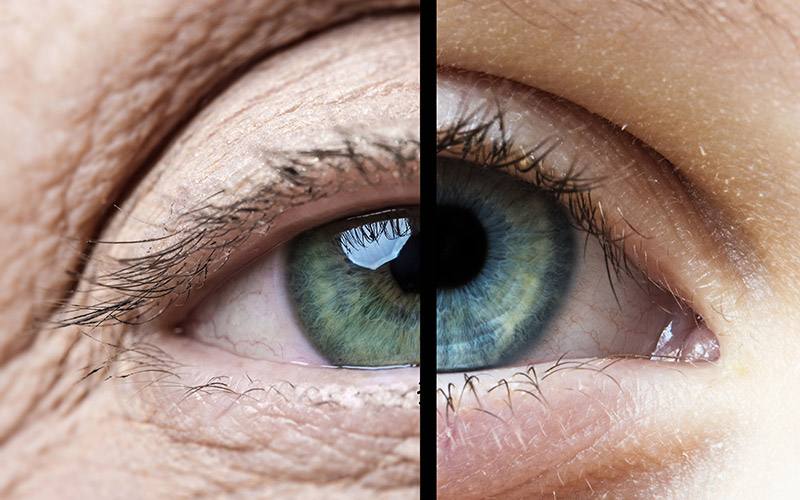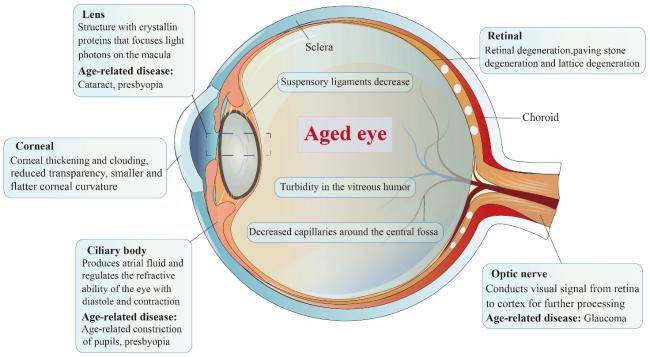


Date: 08 Jul 2025
As we age, our bodies inevitably undergo physical changes—and our eyes are no exception. These changes often begin in our 40s and gradually affect how clearly, we see and how comfortably our eye’s function. Understanding these shifts can empower you to take proactive steps to protect your vision and maintain independence.
By age 40, the lens in your eye begins to stiffen—a condition called presbyopia—making it difficult to focus on close objects like books or smartphones. This common age-related farsightedness often leads individuals to hold items farther away or seek reading glasses.
Aging causes the pupil to shrink and respond more slowly to light changes, impairing night vision and visibility in low-light conditions. You may also struggle to distinguish between similar shades and perceive reduced contrast, making daily tasks like driving or reading more difficult.
Tear production declines with age, often leading to dry, irritated eyes. Friction from eyelid changes and weakened glands may worsen the situation, causing discomfort, redness, and frequent tearing.
The lens becomes progressively yellowed and less transparent, particularly due to oxidative stress. This clouding reduces light transmission to the retina, resulting in blurry vision, halos around lights, color fading, and eventual difficulty driving or reading .
Aging increases the risk of age-related macular degeneration (AMD), which attacks central vision needed for seeing fine details and crucial activities like reading or recognizing faces . As the macula deteriorates, straight lines may appear warped, and detailed vision diminishes.
While common glaucoma is often symptomless, it causes slow deterioration of peripheral vision due to optic nerve damage. Regular eye exams become vital, as early stages of glaucoma are often unnoticed .
Shrinkage of the vitreous humor can result in floaters—tiny specks in vision that usually aren't harmful but may require evaluation if sudden or persistent .

Effective management rests on early detection, corrective aids, and lifestyle adjustments:

Supplements rich in antioxidants, carotenoids, and zinc—similar to AREDS/AREDS2 formulas—may slow progression of age-related eye diseases such as AMD. Pharmily Kenya offers several excellent options:
A comprehensive eye-health supplement containing lutein, zeaxanthin, vitamins A, C, E, and zinc. Supports digital eye strain relief and macular protection from oxidative and blue light damage.
Designed to support macular health, this blend offers lutein, zeaxanthin, vitamin C, and E. Ideal for those who spend long hours in front of screens or are concerned about early AMD.
A powerful formula featuring lutein, zeaxanthin, bilberry, omega‑3, vitamins A, C, E, zinc, selenium, and alpha-lipoic acid—targeting comprehensive eye and retinal support with anti-inflammatory benefits.
Combines lutein, bilberry extract, and zinc—helping reduce eye fatigue, protect the retina, and filter harmful light, especially beneficial for aging eyes and screen exposure.
Supplements like AREDS2-type formulas (with lutein, zeaxanthin, zinc, vitamins C/E) don’t prevent vision aging entirely but help slow progression of conditions like AMD.
After age 40, it’s recommended to have eye exams every 1–2 years. If you have existing eye disease, more frequent visits may be necessary .
Cataract surgery is advised when vision impairment affects daily activities like reading, driving, or recognizing faces. It’s one of the most effective and safest surgical procedures
Ensure regular eye exams to check for cataracts and AMD, use anti-glare lenses, maintain proper lighting, avoid night driving when tired, and wear quality sunglasses during the day .